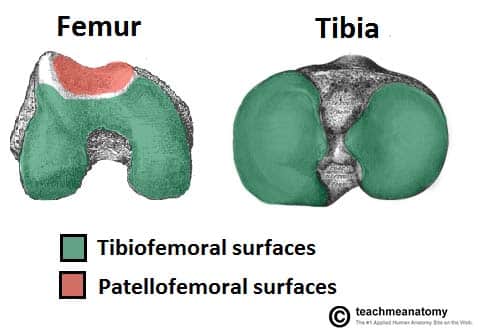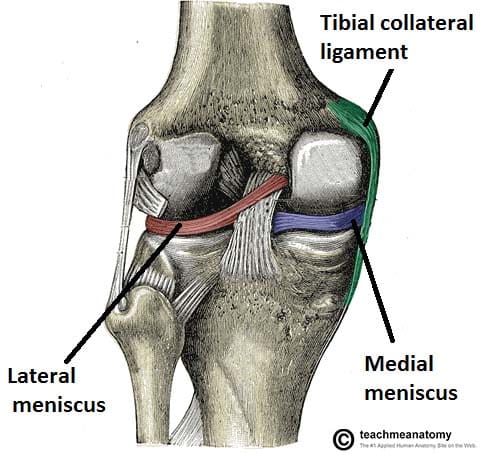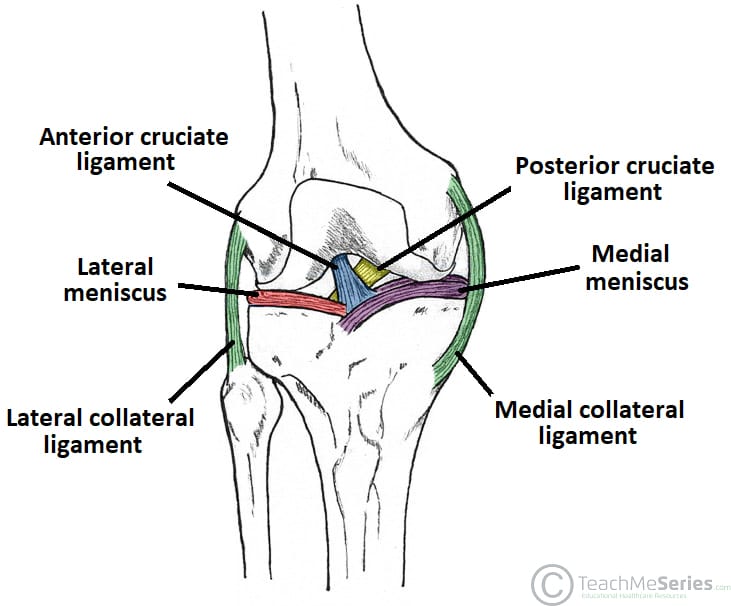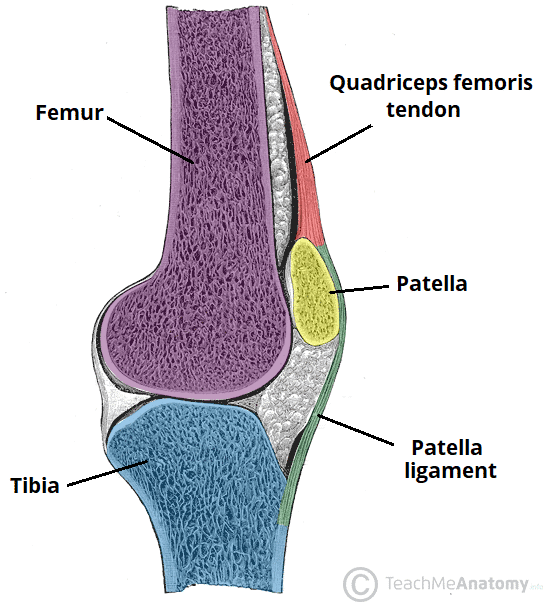The knee joint is a hinge type synovial joint, which mainly allows for flexion and extension (and a small degree of medial and lateral rotation). It is formed by articulations between the patella, femur and tibia.
In this article, we shall examine the anatomy of the knee joint – its articulating surfaces, ligaments and neurovascular supply.
Premium Feature
3D Model
Articulating Surfaces
The knee joint consists of two articulations – tibiofemoral and patellofemoral. The joint surfaces are lined with hyaline cartilage and are enclosed within a single joint cavity.
- Tibiofemoral – medial and lateral condyles of the femur articulate with the tibial condyles. It is the weight-bearing component of the knee joint.
- Patellofemoral – anterior aspect of the distal femur articulates with the patella. It allows the tendon of the quadriceps femoris (knee extensor) to be inserted directly over the knee – increasing the efficiency of the muscle.
As the patella is both formed and resides within the quadriceps femoris tendon, it provides a fulcrum to increase power of the knee extensor and serves as a stabilising structure that reduces frictional forces placed on femoral condyles.

Fig 2
More detailed view of the bony surfaces. The inferior surface of the femur and superior surface of the tibia is shown.
Premium Feature
Dissection Images

Neurovascular Supply
The blood supply to the knee joint is through the genicular anastomoses around the knee, which are supplied by the genicular branches of the femoral and popliteal arteries.
The nerve supply, according to Hilton’s law, is by the nerves which supply the muscles which cross the joint. These are the femoral, tibial and common fibular nerves.
Menisci
The medial and lateral menisci are C-shaped fibrocartilage rings located within the knee joint. They serve two main functions:
- Deepens the articular surface of the tibia – increasing the stability of the joint.
- Acts as shock absorbers– increasing surface area to further dissipate forces that are transmitted across the joint.
They are attached at both ends to the intercondylar area of the tibia. In addition to this attachment, the medial meniscus is also fixed to the medial collateral ligament and the joint capsule. Damage to the medial collateral ligament is often associated with a medial meniscal tear.
The lateral meniscus is smaller and does not have any additional attachments, rendering it more mobile.

Fig 3
Posterior view of the knee joint, with the joint capsule removed. Note the close relationship of the tibial collateral ligament, and the medial meniscus
Bursae
A bursa is a sac-like structure containing a small amount of synovial fluid. It functions to decrease friction between tendons, bone, and skin during movement. There are four main bursae found in the knee joint:
- Suprapatellar bursa – located between the quadriceps femoris and the femur.
- Prepatellar bursa – located between the apex of the patella and the skin.
- Infrapatellar bursa – split into deep and superficial. The deep bursa lies between the tibia and the patella ligament. The superficial lies between the patella ligament and the skin.
- Semimembranosus bursa – located posterior to the knee joint, between the semimembranosus muscle and the medial head of the gastrocnemius.
Ligaments
The major ligaments in the knee joint are:
- Patellar ligament – a continuation of the quadriceps femoris tendon distal to the patella. It attaches to the tibial tuberosity.
- Collateral ligaments – two strap-like ligaments. They act to stabilise the hinge motion of the knee, preventing excessive medial or lateral movement
- Medial collateral ligament – wide and flat ligament, found on the medial side of the joint. Proximally, it attaches to the medial epicondyle of the femur, distally it attaches to the medial condyle of the tibia.
- Lateral collateral ligament – thinner and rounder than the medial collateral ligament. It attaches proximally to the lateral epicondyle of the femur and distally to a depression on the lateral surface of the fibular head.
- Cruciate Ligaments – these two ligaments connect the femur and the tibia. In doing so, they cross each other, hence the term ‘cruciate’ (Latin for like a cross)
- Anterior cruciate ligament – attaches at the anterior intercondylar region of the tibia where it blends with the medial meniscus. It ascends posteriorly to attach to the femur in the intercondylar fossa. It prevents anterior dislocation of the tibia onto the femur.
- Posterior cruciate ligament – attaches at the posterior intercondylar region of the tibia and ascends anteriorly to attach to the anteromedial femoral condyle. It prevents posterior dislocation of the tibia onto the femur.

Fig 6
Anterior view of the knee joint, showing some of the major ligaments. The patella ligament is situated on the anterior aspect of the knee joint, and is not visible is this diagram.
Movements
There are four main movements that the knee joint permits:
- Extension – produced by the quadriceps femoris, which inserts into the tibial tuberosity.
- Flexion – produced by the hamstrings, gracilis, sartorius and popliteus.
- Lateral rotation – produced by the biceps femoris.
- Medial rotation – produced by five muscles; semimembranosus, semitendinosus, gracilis, sartorius and popliteus.
NB: Lateral and medial rotation can only occur when the knee is flexed (if the knee is not flexed, the medial/lateral rotation occurs at the hip joint).
Clinical Relevance
Injury to the Knee Joint
Collateral Ligaments
Injury to the collateral ligaments is the most common pathology affecting the knee joint. It is caused by a force being applied to the side of the knee when the foot is placed on the ground.
Damage to the collateral ligaments can be assessed by asking the patient to medially rotate and laterally rotate the leg. Pain on medial rotation indicates damage to the medial ligament, pain on lateral rotation indicates damage to the lateral ligament.
If the medial collateral ligament is damaged, it is more than likely that the medial meniscus is torn, due to their attachment.
Cruciate Ligaments
The anterior cruciate ligament (ACL) can be torn by hyperextension of the knee joint, or by the application of a large force to the back of the knee with the joint partly flexed. To test for this, you can perform an anterior drawer test, where you attempt to pull the tibia forwards, if it moves, the ligament has been torn.
The most common mechanism of posterior cruciate ligament (PCL) damage is the ‘dashboard injury’. This occurs when the knee is flexed, and a large force is applied to the shins, pushing the tibia posteriorly. This is often seen in car accidents, where the knee hits the dashboard. The posterior cruciate ligament can also be torn by hyperextension of the knee joint, or by damage to the upper part of the tibial tuberosity.
To test for PCL damage, perform the posterior draw test. This is where the clinician holds the knee in flexed position, and pushes the tibia posteriorly. If there is movement, the ligament has been torn.
Bursitis
Friction between the skin and the patella cause the prepatellar bursa to become inflamed, producing a swelling on the anterior side of the knee. This is known as housemaid’s knee.
Similarly, friction between the skin and tibia can cause the infrapatellar bursae to become inflamed, resulting in what is known as clergyman’s knee (classically caused by clergymen kneeling on hard surfaces during prayer).
Unhappy Triad (Blown Knee)
As the medial collateral ligament is attached to the medial meniscus, damage to either can affect both structure’s functions. A lateral force to an extended knee, such as a rugby tackle, can rupture the medial collateral ligament, damaging the medial meniscus in the process. The ACL is also affected, which completes the ‘unhappy triad’.


